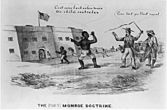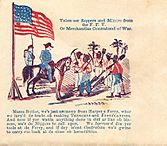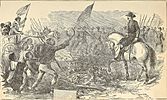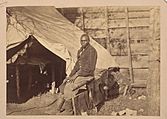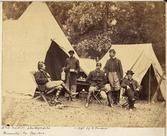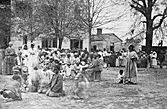Contraband (American Civil War) facts for kids
Contraband was a special word used by the US military during the American Civil War. It described a new status for enslaved people who escaped or joined the Union army.
In August 1861, the Union Army and the US Congress decided they would no longer send escaped enslaved people back to their owners. Instead, these individuals were called "contraband of war." This meant they were treated like captured enemy property. Many of them worked as laborers to help the Union war effort and soon started getting paid.
These former enslaved people created camps near Union forces. The army helped support and educate both adults and children in these camps. Thousands of men from these camps joined the United States Colored Troops when recruitment began in 1863. By the end of the war, there were over 100 contraband camps in the Southern United States. One famous camp was the Freedmen's Colony of Roanoke Island in North Carolina, where 3,500 former enslaved people worked to build their own community.
Contents
How the "Contraband" Idea Started
The question of what to do with enslaved people from the Confederate states came up early in the Civil War, in 1861. At Fort Monroe in Virginia, Major General Benjamin Butler was in charge. He learned that three enslaved men had escaped from Confederate-held Norfolk County and arrived at Fort Monroe, which was controlled by the Union.
General Butler decided not to send these escaped men back to their owners, who supported the Confederacy. He treated them as "contraband." This was a new idea at the time.
The First Three Contrabands
The three men were Frank Baker, James Townsend, and Sheppard Mallory. Their owners had rented them out to the Confederate Army to help build defenses at Sewell's Point. This location was across the water from Fort Monroe. The men escaped at night and rowed a small boat to Old Point Comfort, seeking safety at Fort Monroe.
Before the war, a law called the 1850 Fugitive Slave Act would have required General Butler to return the men. But Virginia had left the United States. General Butler, who was also a lawyer, argued that if Virginia considered itself a separate country, then he didn't have to follow US laws about returning enslaved people. He decided to keep them as "contraband of war."
At first, General Butler did not pay these escaped individuals for their work. He still called them "slaves." However, on September 25, 1861, the Secretary of the Navy, Gideon Welles, ordered that "persons of color, commonly known as contrabands," working for the Union Navy should be paid $10 a month. Three weeks later, the Union Army started paying male "contrabands" at Fort Monroe $8 a month and females $4.
In August 1861, the US Congress passed the Confiscation Act of 1861. This law said that any property used by the Confederate military, including enslaved people, could be taken by Union forces. The next year, another law, the Act Prohibiting the Return of Slaves, made it illegal to return enslaved people to Confederate owners or the military.
Life in the Contraband Camps
News of General Butler's decision spread quickly among enslaved communities in southeastern Virginia. Becoming a "contraband" didn't mean full freedom, but many saw it as a step toward it. The day after Butler's decision, many more escaped enslaved people arrived at Fort Monroe.
Soon, there were too many people to fit inside the fort. So, the contrabands built homes outside the crowded base using materials from the burned City of Hampton. They named their new settlement Grand Contraband Camp, also known as "Slabtown." By the end of the war in April 1865, about 10,000 escaped enslaved people had sought "contraband" status, with many living nearby.
Across the South, Union forces managed more than 100 contraband camps. Not all were as large as Grand Contraband Camp. For example, 1,500 contrabands at Harpers Ferry were returned to slavery when Confederates captured the town.
Education and Emancipation
Near Fort Monroe, outside its protective walls, a brave teacher named Mary S. Peake began teaching both adults and children among the contrabands to read and write. She was the first black teacher hired by the American Missionary Association. This group also sent many white teachers from the North to the South to teach.
This area later became part of Hampton University, a famous historically black college. Even though Virginia had a law against educating enslaved people, Peake and other teachers held classes outdoors under a large oak tree. In 1863, President Abraham Lincoln's Emancipation Proclamation was read to the contrabands and free black people under this tree. Because of this, the tree was named the Emancipation Oak.
For most contrabands, full freedom did not come until the Thirteenth Amendment to the United States Constitution was approved in late 1865. This amendment officially ended slavery in the United States.
Growth of the Camps
Contraband camps grew around many Union forts and army camps. In 1863, after the Emancipation Proclamation and the creation of black military units, thousands of former enslaved people and free black individuals began to join the United States Colored Troops. The army allowed their families to stay safely in the contraband camps. Black troops eventually made up almost 10 percent of all soldiers in the Union Army.
By the end of the war, over 100 contraband camps had been set up in the South. Many of these camps received help from teachers who came from the North. These teachers were often sent by groups like the American Missionary Association. They, along with free black people and freedmen, believed that educating the former enslaved people was extremely important. Teachers often wrote about how much both adults and children wanted to learn to read and write.
Images for kids
-
A cartoon from the time showing enslaved people escaping to Fort Monroe after General Butler's decision. The policy was sometimes called the "Fort Monroe Doctrine."
-
A contraband camp at Harpers Ferry, around 1861. You can see John Brown's Fort in the background.
-
A photo titled: "What do I want, John Henry"?, from Warrenton, Virginia, 1862. It shows John Henry (second from left) and four Union officers.


